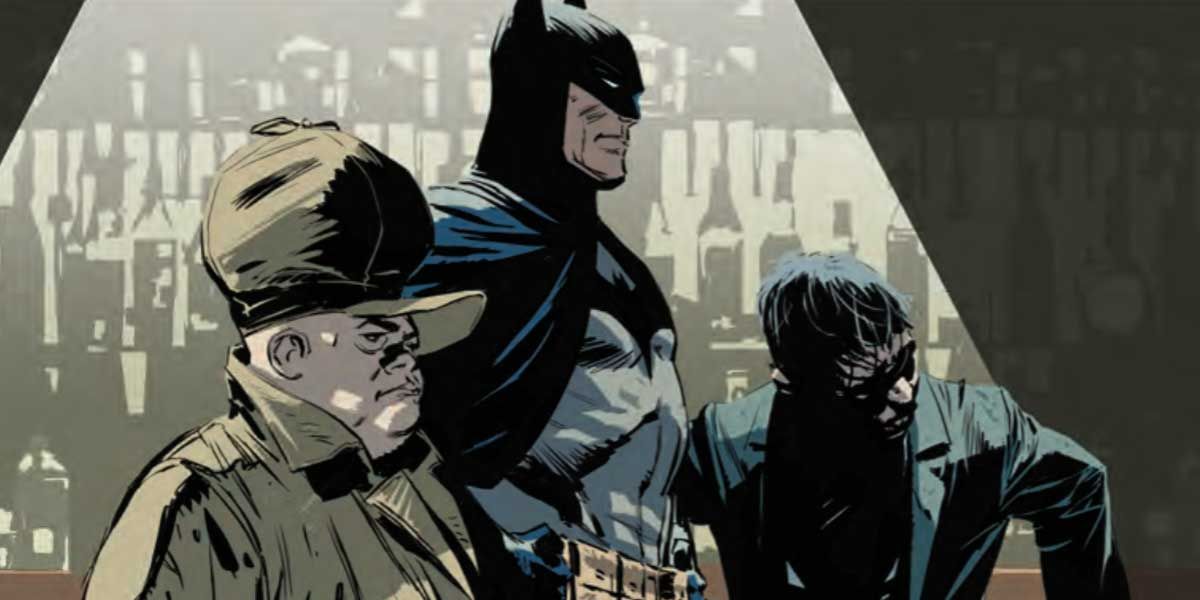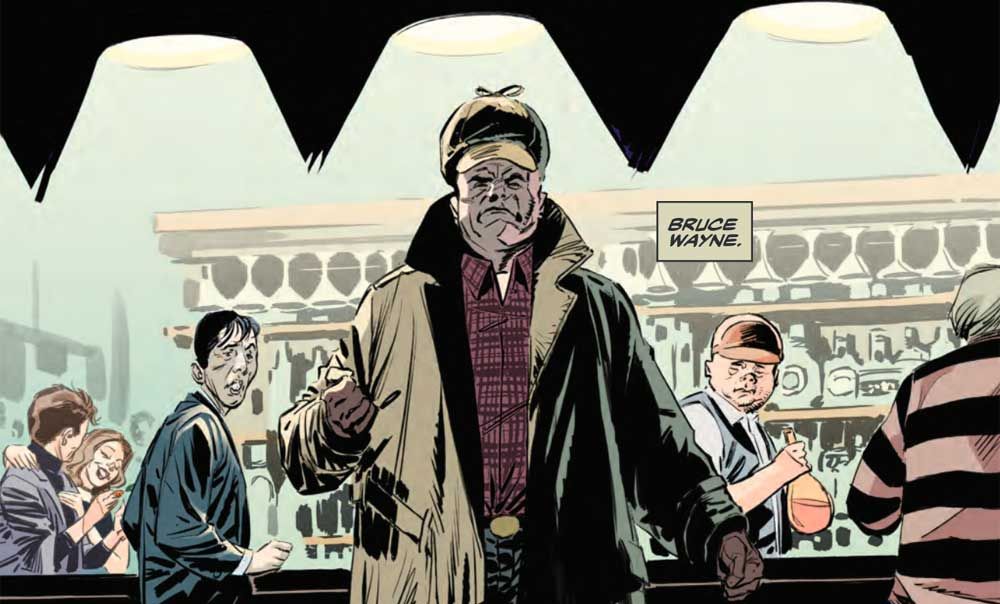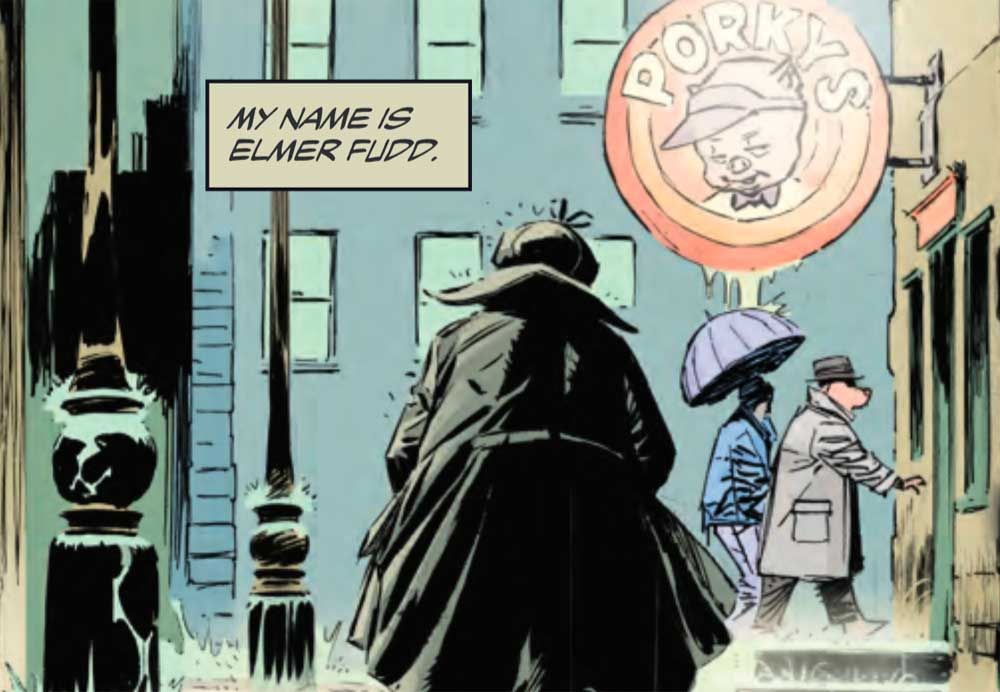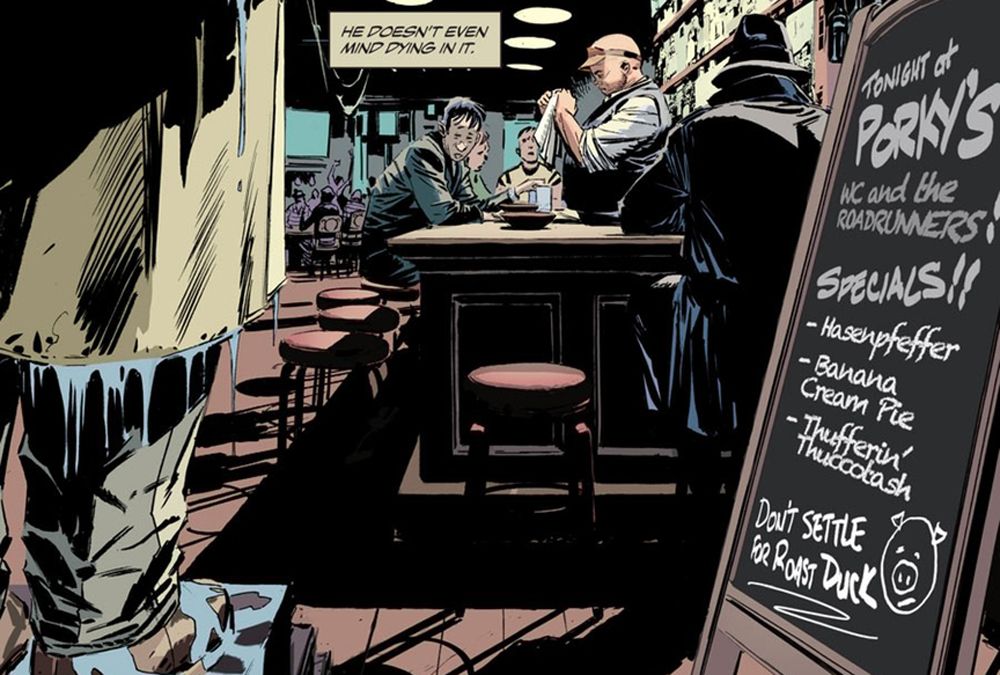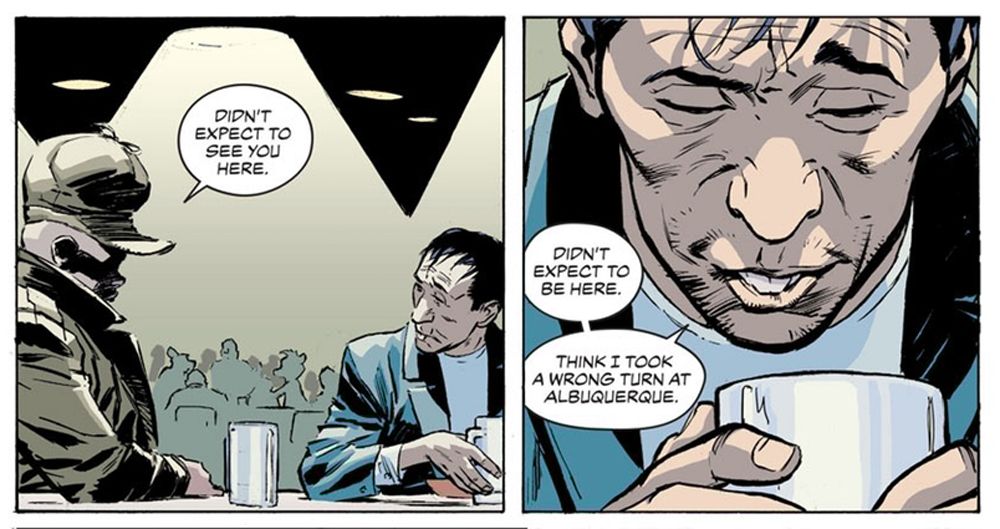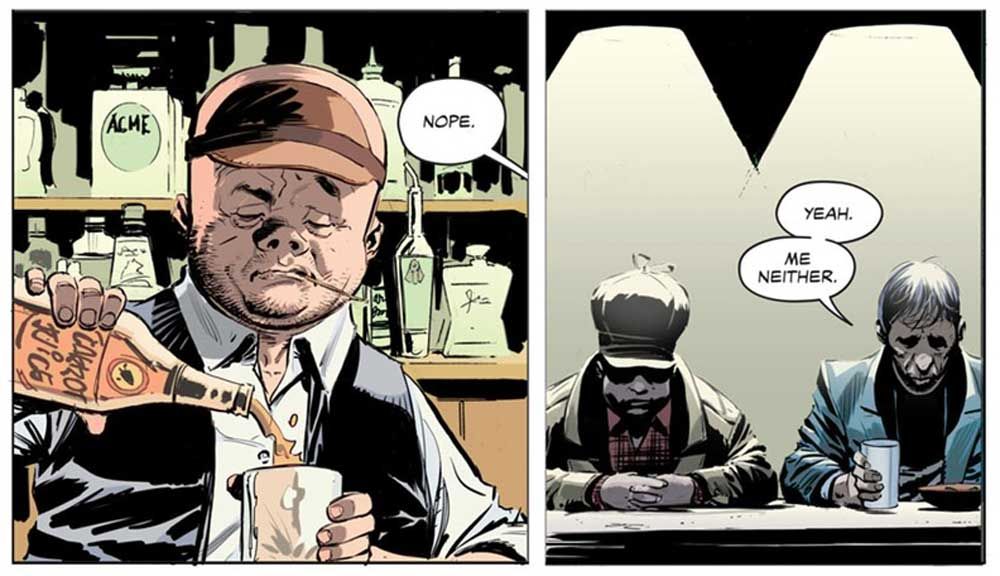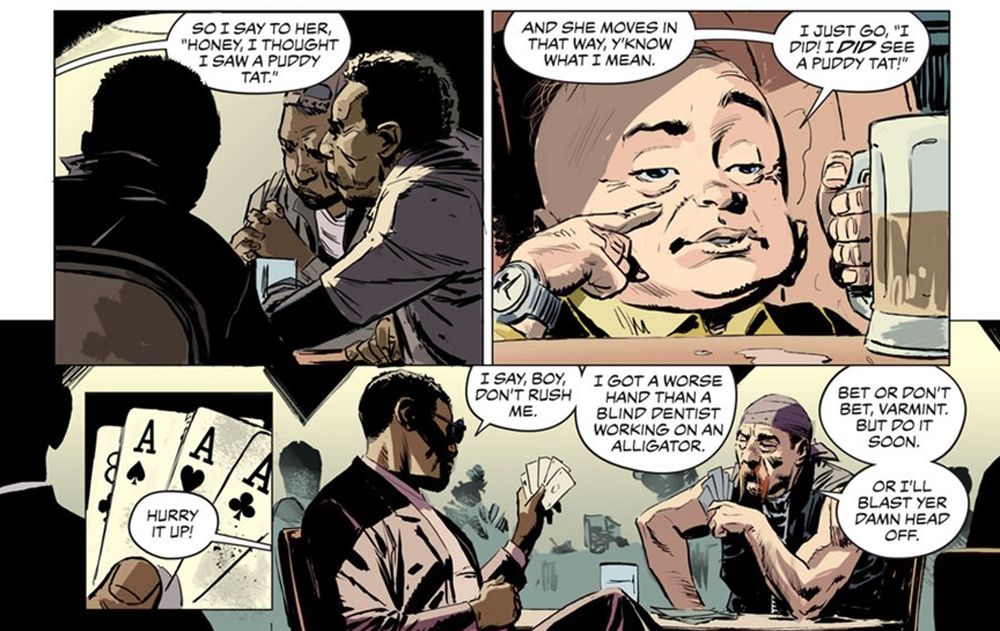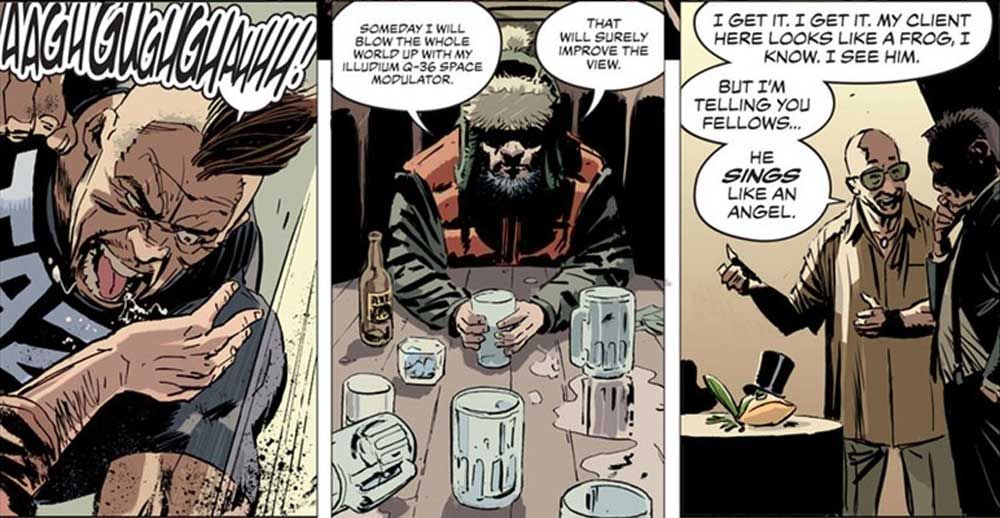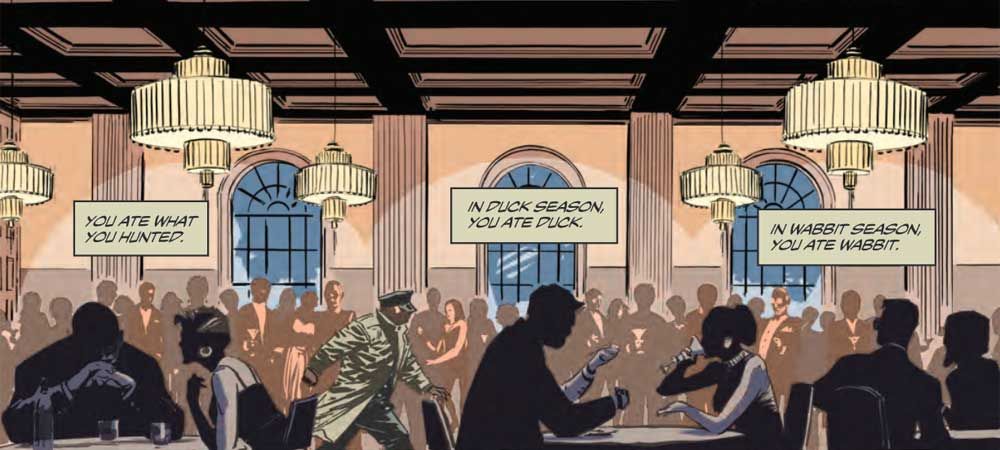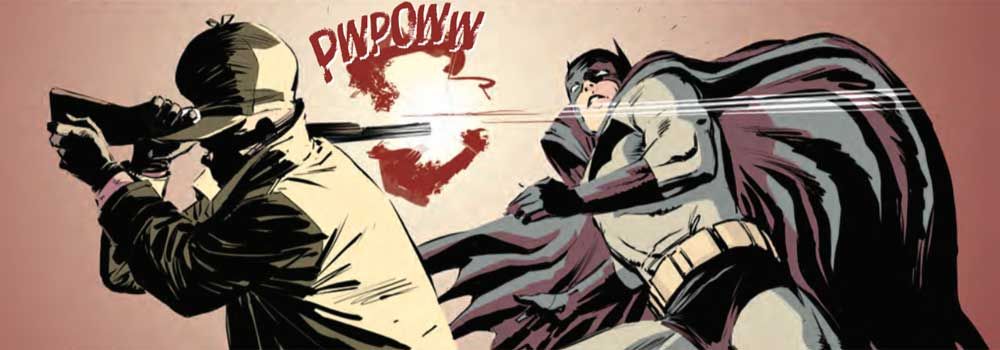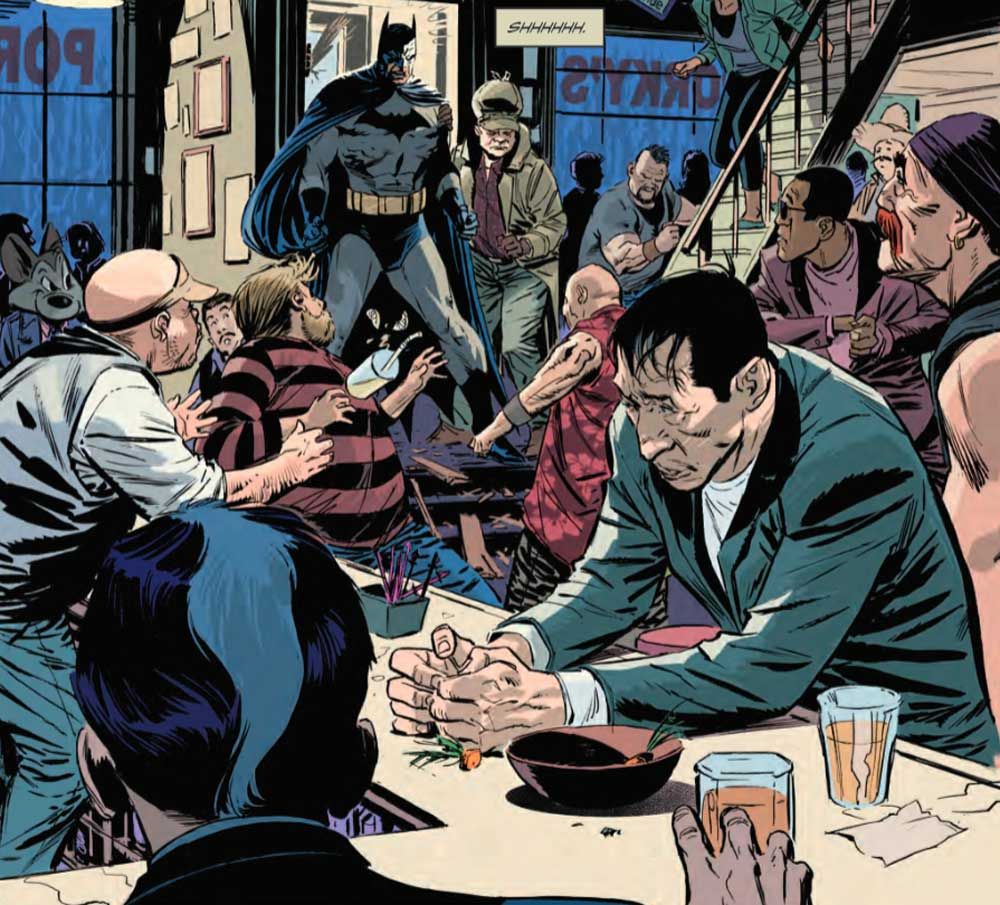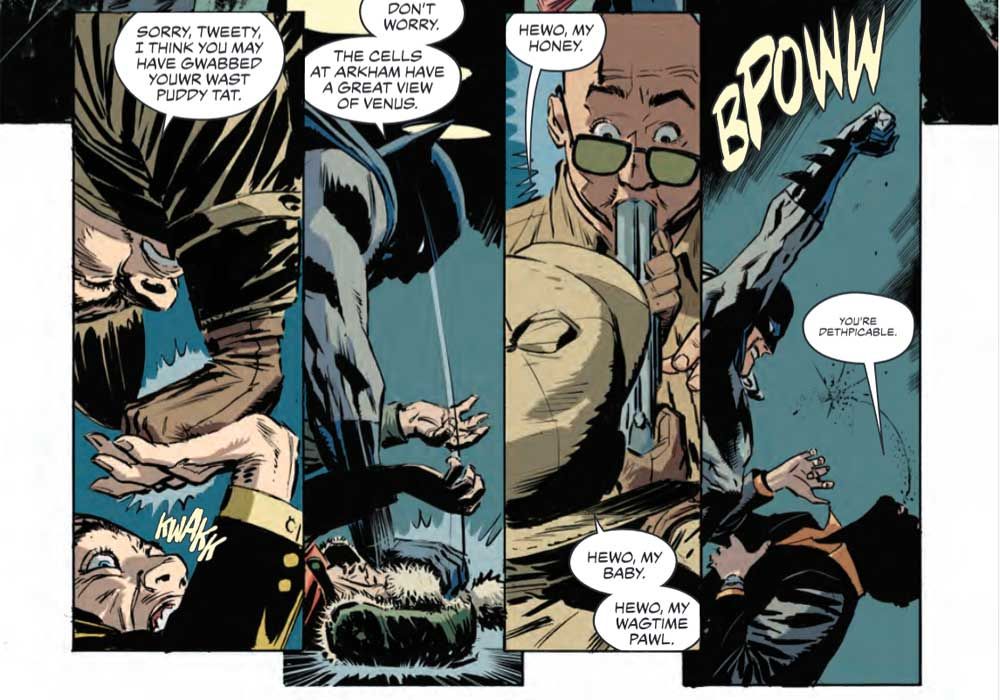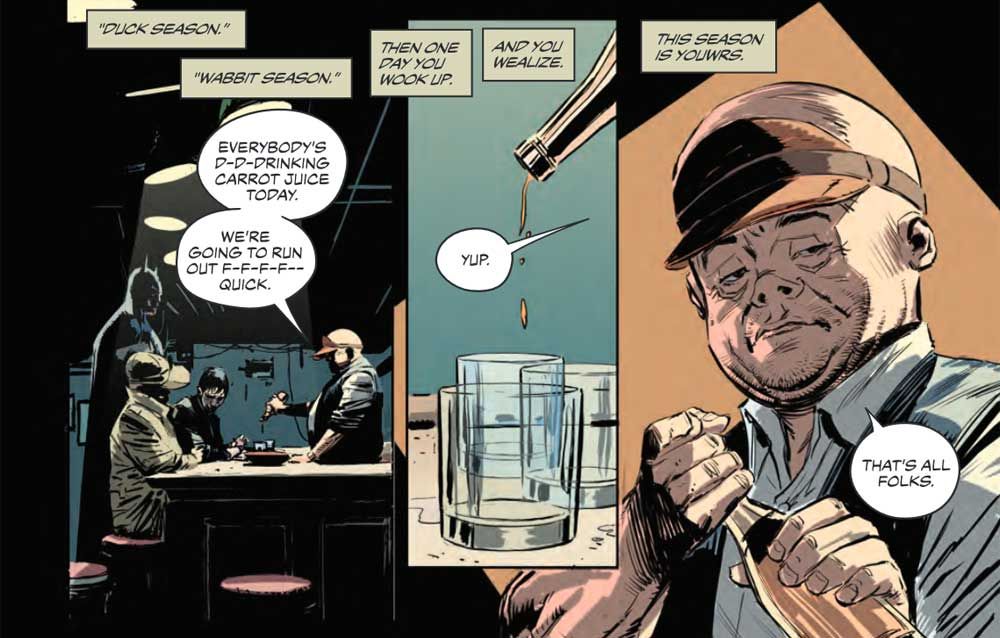In the latest DC Comics/Looney Tunes crossover, Elmer J. Fudd is no longer the hapless hunter so bewildered by Bugs Bunny and Daffy Duck that he doesn't know what season it is. Instead, he's a former hired-killer lured out of retirement and prowling the seedy underbelly, and glittering heights, of Gotham City in the hunt for vengeance. He's absolutely hard-boiled -- or, rather, hawd-boiwed.
REVIEW: King & Weeks' Batman/Elmer Fudd Is Comics Noir At Its Finest
Written by Tom King and illustrated by Lee Weeks and Lavern Kindzierski, Batman/Elmer Fudd #1 is Chuck Jones' "hunting trilogy" by way of Batman: Year One, in which iconic cartoon characters are reimagined as seedy, all-too human patrons of a dive bar where colorful (and somewhat familiar) criminals drown their sorrows and, just maybe, fade away.
The story is absolutely packed with Looney Tunes references, most of which we unpack below.
His Name Is Elmer Fudd
A short-tempered, well-armed man who seemingly never wins (What's Opera, Doc? and a few other instances aside), Elmer J. Fudd is ripe for the noir treatment. Long the butt of Bugs Bunny's jokes, in Batman/Elmer Fudd he's played straight (like the rest of the Looney Tunes characters), even tragic.
All of his trademarks remain -- the hunting cap, the shotgun, the speech impediment -- but this Elmer is a hired killer out to avenge the woman who had convinced him to put away the gun and turn his back on that life. "I'm hunting wabbits," he says on the first page, offering up his catchphrase. But his prey soon changes to "pwayboys," and one in particular.
Porky's Revenge
The Gotham City dive bar is, of course, named after Porky Pig, the Merrie Melodies and Looney Tunes character introduced in 1935, predating Bugs Bunny by five years. Although the human version of Porky serves drinks inside, here we see his more traditional cartoon depiction on the sign, with a bull's-eye background that mimics the "That's All Folks!" title card at the end of Looney Tunes shorts.
RELATED: Batman Rebirth, Year One: A Look Back At Tom King's Bat-Epic, So Far
It's worth pointing out the anthropomorphized animal in a trench coat entering Porky's, as are nearly all of the other characters in this story are human. More specifically, they're "realistic," human renditions of well-known, even iconic, cartoon characters.
As an aside: It surely can't be an accident that the bar is called Porky's (and not, say, Daffy's or Tweety's), the title of the 1981 sex comedy that revolves around a backwoods nightclub with a racy animated neon sign depicting Porky and Petunia Pig.
Where's My Hasenpfeffer?
The sandwich board inside Porky's boasts a handful of Looney Tunes references, beginning with the band, WC and the Roadrunners, a nod to Wile E. Coyote and the Road Runner, the popular rivals who debuted in the 1949 short Fast and Furry-ous.
Hasenpfeffer is a stewed-rabbit dish drawn from the 1962 short Shishkabugs, in which Yosemite Sam is the chef for a demanding king who's dissatisfied both by the variety and the speed of his meals. ("Cook! Cook! Where's my lunch? Where's my dinner?") Wanting something different, the king orders hasenpfeffer, which sends Sam in pursuit of Bugs Bunny.
RELATED: Batman: War of the Jokes' Inciting Incident Revealed
Banana cream pie is probably a nod to the 1947 Merrie Melodies short Slick Hare, in which Elmer Fudd is the chef at an upscale nightclub whose efforts to serve fried rabbit are frustrated by Bugs Bunny. In one scene, Bugs masquerades as a waiter who orders first lemon meringue and then banana cream pie, only to hit Elmer in the face with them.
While succotash is a dish of corn and lima beans, thufferin' thuccotash is of course Sylvester the Cat's signature exclamation, which makes an appearance later in this story. "Don't settle for roast duck" is an obvious reference to Daffy, who has the briefest of cameos, but if it's from a specific cartoon, I can't find it. A character's desire to eat roast duck (or any food, for that matter) is a recurring setup for Daffy Duck shorts.
Bugs "The Bunny" Takes a Wrong Turn
Readers don't need narration, or that signature opening line "Eh ... What's up, doc?," to decipher the identity of this shady trickster. Weeks gives the character wonderfully rabbit-like physical features, from the shape of his head to his oversized front teeth, without becoming overly cartoonish. Oh, and he's munching on little carrots while drinking carrot juice, naturally.
Elmer observes that Bugs loves "the game" so much that "he doesn't even mind dying in it," a pretty grim characterization of their 77-year relationship, but accurate nonetheless. From their first meeting in 1940's Elmer's Candid Camera, Bugs (then in his "Happy Rabbit" form) has relished the hunt, probably in no small part because he typically gets the best of Elmer. He does so again in "Pway for Me," escaping almost-certain death by sending a vengeful Elmer on the trail of Bruce Wayne.
The conversation between Elmer and Bugs is similar in rhythm, if not in tone, to that of their lighthearted animated counterparts. However, Bugs' lament "Think I took a wrong turn a wrong turn at Albuquerque" is a direct reference to the cartoons, where variations of the phrase have served as the setup for numerous adventures, beginning with 1945's Herr Meets Hare. Their tense encounter ends with "Ain't I a stinker?," an admission -- and perhaps admiration -- of his own deviousness that's second only to "What's up, doc?" in Bugs Bunny's lexicon.
ACME and Carrot Juice
Porky pours another glass of carrot juice for Bugs, whose animated analog has a long, and not entirely happy, history with the stuff. For instance, after waking up hung over from mixing radish juice and carrot juice in 1958's Hare-Way to the Stars, Bugs unwittingly walks out of his hole and into a rocket that's launched into space, where he encounters Marvin the Martian, and in 1951's The Fair-Haired Hare, Yosemite Sam attempts to kill him by poisoning the beverage.
Considering the ACME Corporation's rather diverse catalog, it probably shouldn't be surprising to see "ACME" on the bottle of liquor behind Porky. Featured prominently in the Wile E. Coyote and Road Runner cartoons, the fictional conglomerate has supplied mail-order products ranging from rocket-powered roller skates and bird seed to a Bat-Man outfit and a tornado kit, not all of which were exactly reliable.
Tweety, Foghorn Leghorn and Yosemite Sam Walk Into a Bar ...
Dressed in yellow, the diminutive human version of Tweety holds court at Porky's, where he turns his catchphrase "I thought I saw a puddy tat" into what may be the punchline of a dirty story. If so, that's a delightful subversion of the little canary, who's typically depicted as wholesome, even if in his earliest appearances he displayed a nasty streak in his interactions with feline foes.
Nearby, Foghorn Leghorn and Yosemite Sam, each identifiable by his signature verbal quirks -- "I say, boy" and "varmint," for starters -- and the latter by his bushy orange mustache, play a game of poker. It's an interesting pairing, as the two don't share an onscreen history. While Foghorn, the Leghorn rooster introduced in 1946's Walky Talky Hawky, is a protagonist, he's typically the aggressor, instigating pranks against frequent foil Barnyard Dawg. Yosemite Sam, whose decades-old rivalry with Bugs Bunny dates to 1945's Hare Trigger (an early version of him appeared the year before), is quick to anger, and gunfire. Together, they're undoubtedly volatile.
Tasmanian Devil, Marvin the Martian and Michigan J. Frog
The next row of panels introduces some of Porky's other patrons, beginning with the Tasmanian Devil, or "Taz" if you'd rather go with his nickname, or the letters on his shirt. Introduced in 1954's Devil May Hare, Taz is Looney Tunes' ferocious, and voracious, agent of chaos and destruction who, as Bugs Bunny learned in 1957's Bedeviled Hare, will eat just about anything, from aardvarks and elephants to wildebeests and, yes, rabbits. Here, however, he seems content with pummeling a fellow bar customer.
The oddly attired fellow muttering to himself over far too many drinks is Marvin the Martian, who's exchanged his green-and-orange Roman soldier uniform for a slightly less-conspicuous green ushanka and jacket, and orange quilted vest. Debuting in 1948's Haredevil Hare, the soft-spoken foe of Bugs Bunny and Daffy Duck (in his Duck Dodgers role) routinely plots the destruction of Earth, twice using theIlludium Q-36 Explosive Space Modulator (actually an enormous stick of dynamite), to improve his view of Venus.
Perhaps the least-changed Looney Tunes character in Batman/Elmer Fudd is Michigan J. Frog, who's depicted as a disinterested bullfrog wearing a top hat. While '90s kids may best remember him as the mascot of The WB, the character debuted four decades earlier, in 1955's One Froggy Evening. Discovered by a construction worker within the cornerstone of a demolished building, the frog produces a top hat and cane, and belts out ragtime and Tin Pan Alley favorites. However, the man's attempts to cash in on his amazing discovery, or simply convince an irritated police officer that it's the frog who's disturbing the peace, Michigan falls silent, and mysteriously loses his top hat. Here, the man is futilely attempts to convince another Porky's patron of the frog's abilities.
Duck! Rabbit, Duck!
The story is filled with clever twists on Looney Tunes characters and tropes, but the most intriguing -- and, really, the most profound -- comes as Elmer Fudd, disguised as a chauffeur, infiltrates a party on Wayne Manor, intent on killing Bruce Wayne in retribution for the death of the love of his life, Silver St. Cloud. King turns the often-quoted argument of contradictions, "Duck season! Rabbit season!," from Chuck Jones' "hunting trilogy" (Rabbit Fire, Rabbit Seasoning and Duck! Rabbit, Duck!) into a rumination about the lessons learned from growing up in poverty, and doing whatever it takes to survive.
"I didn't gwow up in the fancy of the city," Elmer says in narration. "I gwew up in the dirt of the country. You ate what you hunted. In duck season, you ate duck. In wabbit season, you ate wabbit. You didn't find your pway, you starved. So you wearned to find your pway."
"Duck season" and "wabbit season" reemerge at the end of the story, again as Elmer turns philosophical, and tries to turn the page.
BWANG! PWPOWW!
A delightfully clever touch that just might have escaped the notice of some readers is Elmer Fudd's sound effects: They're tailored to reflect his trademark speech impediment. Batman's actions are accompanied by traditional comic book effects -- "KRAKK" when he kicks Elmer, "POWW" when he punches Yosemite Sam -- but Elmer's are ... different. When he opens a door, it's with a "SKWEEEEK," and when he fires his shotgun, it's with a "PWPOWW."
And Tweety's wrist? Elmer snaps it with a perfectly understated "KWAKK." Chalk it up to those hollow little bird bones.
'A Hawd Pwace for Hawd Men'
One could argue that the Elmer Fudd of this DC one-shot is as easily manipulated as his animated counterpart, by Bugs "The Bunny," by Batman, and by his beloved Silver St. Cloud. After Elmer seemingly kills Bruce Wayne, the Dark Knight convinces him that 1.) the billionaire-playboy survived (he did, of course); and 2.) Bugs is who they really want (he is, sort of). Arriving together at Porky's, this funhouse-mirror version of the Dynamic Duo receives the welcome that Elmer predicted. "This is a hawd pwace for hawd men," he warns Batman. "They won't take kindwy to youwr pwesence."
Before all hell breaks loose, we're treated to a moment of relative quiet that introduces a few additional characters, and a couple of nods to Looney Tunes history. Street signs high on the front wall for "Chuck Jones Blvd." and "Tex Avery Avenue," tributes to the legendary animators and directors behind so many classic shorts.
The room is crammed full of characters, beginning on the far left with Hubie, one-half of the mouse duo Hubie and Bertie, who curiously is shown human-sized, in a coat and tie, but with his traditional face. Introduced by Jones in 1943's The Artisto-Cat, the feline-tormenting mice are relatively easy to tell apart: Hubie has the Brooklyn accent, and Bertie has the buck teeth.
To the right is Porky, followed by Sylvester in the striped shirt (while that's certainly not obvious here, two pages later he yells "Thuffering thuccotash!" as he throws himself at Elmer). To the right of Elmer appears to be Taz again, with Speedy Gonzalez peeking up in the background between Foghorn Leghorn and Yosemite Sam. Bugs remains in the foreground, and Pepé Le Pew, displaying a pronounced white stripe, sits with his back to the reader. (He's glimpsed earlier, on Page 7, with a woman who very well may be Penelope Pussycat, who for the past seven decades has been pursued by the love-stricken Pepé, typically because he mistakes her for a fellow skunk.)
There are three characters here who don't display enough familiar traits to discern their Looney Tunes identities. The man between the heads of Porky and Sylvester could be Daffy, as he's glimpsed mostly in shadow two pages later receiving a beating from Batman. The man in the red floral-print shirt and the woman descending the stairs are mysteries.
They're Dethpicable
Batman and Elmer make quick, brutal work of Porky's customers, and its decor, taking down a gun-toting Yosemite Sam, Foghorn, Sylvester and Taz (in that order) before moving on to the four shown here. Tweety's wrist is almost certainly broken as Elmer delivers what seems like an off-color (and possibly Trumpian) zinger. Meanwhile, the Dark Knight takes down Marvin with the promise of a cell in Arkham Asylum that will provide his long sought-after view of Venus.
The third panel is the unnamed man who unearths the extraordinary (and extraordinarily frustrating) Michigan J. Frog -- Elmer quotes "Hello! Ma Baby," a Tin Pan Alley song favored by the frog -- while the fourth is, of course, Daffy, who utters his catchphrase "You're dethpicable." Note that he's dressed in black and orange, the colors of the anthropomorphic duck.
That's All, Folks
When the Dynamic Duo reach Bugs, it's revealed he didn't kill Silver St. Cloud, but rather staged the crime at the behest of the femme fatale herself, who coolly materializes on a bar stool to explain why: In short, both Bruce Wayne and Elmer Fudd proved too dangerous for her liking. Silver waltzes out of Porky's, and out of their lives, while Batman, Elmer and Bugs remain to drown their sorrows in carrot juice.
As Elmer ponders the changing seasons -- duck season, rabbit season -- Porky empties the last bottle, and utters those words befitting the end of any Looney Tunes story: "That's all folks."
Although that phrase is forever associated with Porky Pig, its use as the official sign-off actually predates the character: It originated with the very first Looney Tune, 1930's Sinkin' in the Bathtub, which ended with Warner Bros.' original cartoon character, Bosko, saying, "That's all, folks." Merrie Melodies of the era closed out with the star of each short proclaiming, "So long, folks!" It wasn't until 1937's Rover's Rival that Porky popped out of the drum (the Looney Tunes bull's-eye didn't become standard until 1946) to say, "Th-th-that's all, folks!"
No, seriously, that's all, folks.

